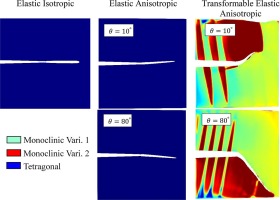当前位置:
X-MOL 学术
›
Comp. Mater. Sci.
›
论文详情
Our official English website, www.x-mol.net, welcomes your feedback! (Note: you will need to create a separate account there.)
Phase field modeling of crack propagation in shape memory ceramics – Application to zirconia
Computational Materials Science ( IF 3.3 ) Pub Date : 2020-03-01 , DOI: 10.1016/j.commatsci.2019.109509 Ehsan Moshkelgosha , Mahmood Mamivand
Computational Materials Science ( IF 3.3 ) Pub Date : 2020-03-01 , DOI: 10.1016/j.commatsci.2019.109509 Ehsan Moshkelgosha , Mahmood Mamivand

|
Abstract Shape memory ceramics (SMCs) are promising candidates for actuators in extreme environments such as high temperature and corrosive applications. Despite outstanding energy dissipation, compared to metallic shape memory materials, SMCs suffer from a sudden brittle fracture. While the interaction of crack propagation and phase transformation in SMCs have been subject of several experimental and theoretical studies, mainly at the macroscale, the fundamental understanding of the dynamic interaction of crack propagation and martensitic transformation is poorly understood. In this work, we use the phase field framework to fully couple the martensitic transformation to the variational formulation of brittle fracture. The model is parameterized for single crystal zirconia which experiences tetragonal to monoclinic transformation during crack propagation. For the mode I of fracture, the opening mode, crack shows an unusual propagation path that is in good agreement with the experiments and indicates the significant role of phase transformation on the crack propagation path. The investigation on the effect of lattice orientation on crack propagation shows that the lattice orientation has a significant influence not only on the crack propagation path but also on the magnitude of the transformation toughening. In a constrained crystal the maximum (minimum) toughening, under mode I loading, occurs when the crystal lattice orientation makes the angle of 50 (90) degrees with the crack surface.
中文翻译:

形状记忆陶瓷裂纹扩展的相场建模——在氧化锆中的应用
摘要 形状记忆陶瓷 (SMCs) 是极端环境(如高温和腐蚀性应用)中执行器的有希望的候选材料。尽管具有出色的能量耗散,但与金属形状记忆材料相比,SMC 会遭受突然的脆性断裂。虽然 SMC 中裂纹扩展和相变的相互作用已经成为一些实验和理论研究的主题,主要是在宏观尺度上,但对裂纹扩展和马氏体转变的动态相互作用的基本理解知之甚少。在这项工作中,我们使用相场框架将马氏体转变完全耦合到脆性断裂的变分公式。该模型被参数化为单晶氧化锆,在裂纹扩展过程中经历四方向单斜转变。对于断裂模式 I,打开模式,裂纹显示出异常的传播路径,与实验非常吻合,表明相变对裂纹传播路径的重要作用。晶格取向对裂纹扩展影响的研究表明,晶格取向不仅对裂纹扩展路径有显着影响,而且对相变韧化的大小也有显着影响。在受约束的晶体中,在模式 I 加载下,当晶格取向与裂纹表面成 50 (90) 度角时,会发生最大(最小)增韧。裂纹显示出一个不寻常的传播路径,与实验非常吻合,表明相变对裂纹传播路径的重要作用。晶格取向对裂纹扩展影响的研究表明,晶格取向不仅对裂纹扩展路径有显着影响,而且对相变韧化的大小也有显着影响。在受约束的晶体中,在模式 I 加载下,当晶格取向与裂纹表面成 50 (90) 度角时,会发生最大(最小)增韧。裂纹显示出一个不寻常的传播路径,与实验非常吻合,表明相变对裂纹传播路径的重要作用。晶格取向对裂纹扩展影响的研究表明,晶格取向不仅对裂纹扩展路径有显着影响,而且对相变韧化的大小也有显着影响。在受约束的晶体中,在模式 I 加载下,当晶格取向与裂纹表面成 50 (90) 度角时,会发生最大(最小)增韧。晶格取向对裂纹扩展影响的研究表明,晶格取向不仅对裂纹扩展路径有显着影响,而且对相变韧化的大小也有显着影响。在受约束的晶体中,在模式 I 加载下,当晶格取向与裂纹表面成 50 (90) 度角时,会发生最大(最小)增韧。晶格取向对裂纹扩展影响的研究表明,晶格取向不仅对裂纹扩展路径有显着影响,而且对相变韧化的大小也有显着影响。在受约束的晶体中,在模式 I 加载下,当晶格取向与裂纹表面成 50 (90) 度角时,会发生最大(最小)增韧。
更新日期:2020-03-01
中文翻译:

形状记忆陶瓷裂纹扩展的相场建模——在氧化锆中的应用
摘要 形状记忆陶瓷 (SMCs) 是极端环境(如高温和腐蚀性应用)中执行器的有希望的候选材料。尽管具有出色的能量耗散,但与金属形状记忆材料相比,SMC 会遭受突然的脆性断裂。虽然 SMC 中裂纹扩展和相变的相互作用已经成为一些实验和理论研究的主题,主要是在宏观尺度上,但对裂纹扩展和马氏体转变的动态相互作用的基本理解知之甚少。在这项工作中,我们使用相场框架将马氏体转变完全耦合到脆性断裂的变分公式。该模型被参数化为单晶氧化锆,在裂纹扩展过程中经历四方向单斜转变。对于断裂模式 I,打开模式,裂纹显示出异常的传播路径,与实验非常吻合,表明相变对裂纹传播路径的重要作用。晶格取向对裂纹扩展影响的研究表明,晶格取向不仅对裂纹扩展路径有显着影响,而且对相变韧化的大小也有显着影响。在受约束的晶体中,在模式 I 加载下,当晶格取向与裂纹表面成 50 (90) 度角时,会发生最大(最小)增韧。裂纹显示出一个不寻常的传播路径,与实验非常吻合,表明相变对裂纹传播路径的重要作用。晶格取向对裂纹扩展影响的研究表明,晶格取向不仅对裂纹扩展路径有显着影响,而且对相变韧化的大小也有显着影响。在受约束的晶体中,在模式 I 加载下,当晶格取向与裂纹表面成 50 (90) 度角时,会发生最大(最小)增韧。裂纹显示出一个不寻常的传播路径,与实验非常吻合,表明相变对裂纹传播路径的重要作用。晶格取向对裂纹扩展影响的研究表明,晶格取向不仅对裂纹扩展路径有显着影响,而且对相变韧化的大小也有显着影响。在受约束的晶体中,在模式 I 加载下,当晶格取向与裂纹表面成 50 (90) 度角时,会发生最大(最小)增韧。晶格取向对裂纹扩展影响的研究表明,晶格取向不仅对裂纹扩展路径有显着影响,而且对相变韧化的大小也有显着影响。在受约束的晶体中,在模式 I 加载下,当晶格取向与裂纹表面成 50 (90) 度角时,会发生最大(最小)增韧。晶格取向对裂纹扩展影响的研究表明,晶格取向不仅对裂纹扩展路径有显着影响,而且对相变韧化的大小也有显着影响。在受约束的晶体中,在模式 I 加载下,当晶格取向与裂纹表面成 50 (90) 度角时,会发生最大(最小)增韧。



























 京公网安备 11010802027423号
京公网安备 11010802027423号